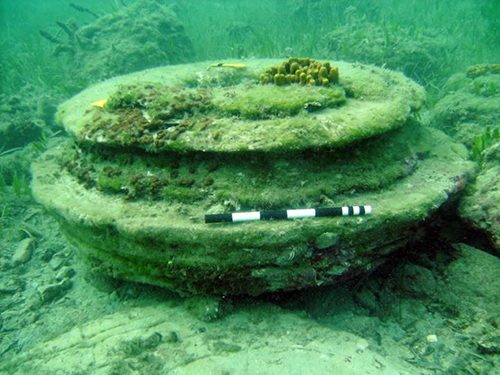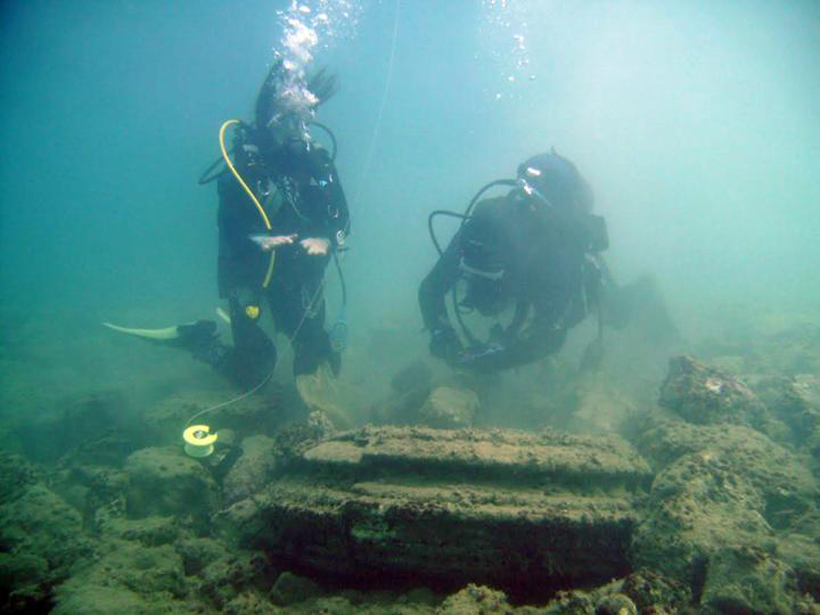In shallow water off the sunny coast of Zakynthos, an island not far from mainland Greece, sponges and seaweed grow on a field of oddly shaped stones. They look like the ruins of a sunken city, complete with pillars, tile-paved streets, and millstones.
But a new study reveals that the structures are actually a fossilized series of hydrocarbon vents, formed 3–4 million years ago. Although some locals are disappointed by the news, the stones provide a valuable window into the past—a far deeper past than archaeology could reveal.
“They do actually, superficially, look like something a person would have made.”
It’s not hard to see where the “sunken city” mistaken identity came from. “They do actually, superficially, look like something a person would have made,” said Kathleen Campbell, a geobiologist at the University of Auckland in New Zealand, who was not involved with the study.
The rocks’ unusual shapes attract attention, she said, adding that in Italy and New Zealand, they often wind up as garden decorations. The stones, which are made of dense white carbonate, also have more practical uses: Because most of them have holes in the middle, the Maori of New Zealand have historically threaded rope through the centers and used them as anchors for their fishing boats.
Built by Microbes
The stones likely formed when methane-rich fluids seeped out of vents on the ocean floor around 3–4 million years ago, during the Pliocene era, according to the paper, recently published in Marine and Petroleum Geology. When deposits of hydrocarbons—often in the form of methane, oil, or tar—are squeezed by tectonic activity, the hydrocarbons can leak out, said Campbell. Sometimes, on the surface, this process forms tar seeps and pits. But on the seafloor, methane-rich fluids and methane gas can provide a bountiful home for microbes that feed on these effluents.
Over time, excretions from these microbes, along with other elements, can form hard, white, hollow towers of carbonate. As the towers grow taller and thicker from layer upon layer of carbonate, their composition captures a history of the surrounding environment. In the chemical makeup of tower layers, the deposits record which kinds of microbes lived on the formations and how much methane was coming out of the vent as the layer accumulated. Occasionally, embedded shells record the presence of larger life-forms around the seep.

Geologists can then cut and analyze these rocks to read the history of the vent. “You take it down to the local masonry guy and get it cut in half, and they say, ‘Whoa! This smells like somebody poured a bunch of kerosene on it while we’re cutting it!’” said Campbell, “and it’s because it’s full of hydrocarbons.”
Eventually, mud may bury the carbonate towers and solidify into soft rock. If that mudstone later erodes away, exposed carbonate becomes visible again—just as it apparently did near modern-day Zakynthos.
Chemical Tests Reveal How Structures Formed
In the new paper, the research team describes how they confirmed that the stones were natural formations and not of human origin. The scientists conducted chemical and structural analyses on samples of the carbonate formations. They determined that the stones were made of a carbonate variety called dolomite. Moreover, measurements of carbon isotope ratios in the formations fell within the ranges found in vent towers elsewhere in the world—in Monterey Bay and the Gulf of Cadiz, for example.
“I think the most telling work was using the stable carbon isotopes,” wrote Julian Andrews, a professor of environmental science at the University of East Anglia in Norfolk, U.K., and lead author of the study, in an email. In addition to revealing which microbes generated the structures, “those results were the fingerprint for methane, and they unlocked the whole microbial process that was happening,” he explained.
The carbonate rocks told the research team that at the time of their formation, the coast off Zakynthos was the site of both a methane seep and the microbes that fed on it. This wasn’t surprising—even today, the island has a tar seep, which is a different but related kind of hydrocarbon seep.

Because most hydrocarbon seeps form deep under water, the nearness to the surface of these seep relics surprised scientists. They suspect that this portion of the seabed has been raised from its original position in the deep sea because they know that the towers would have formed in very cold water, around 2°C. Similar towers grow on the deep seabed at this temperature, which is much colder than waters offshore of Zakynthos today.
The isotope ratios gave other clues as well. They indicated that with the exception of one group of stones, the carbonate towers likely formed in an environment where very little (if any) methane present was organically produced. What’s more, the microbes likely built the exterior of the towers first and then added inner layers over time.
From a Local Vent to a Bigger Climate Picture
Examining the structure of fossilized hydrocarbon seeps can also give scientists a broader picture of Earth’s environment. Other groups of researchers are studying fossilized hydrocarbon vents to find out how much methane they have leaked over the course of Earth’s history and how much impact this has had on global climate. “That’s part of what people are worried about with climate change,” said Campbell. “They’re worried about direct transfer of methane from the seabed in the form of bubbles and flares right up into the atmosphere.”
Some people, including the man who first discovered the Zakynthos site, have expressed disappointment and disbelief that their mysterious sunken city has turned out to be nothing more than a pile of rocks. However, in using those rocks to probe the distant past, scientists delve into a deeper mystery, that of what climate may have looked like millions of years ago.
—Elizabeth Deatrick, Writer Intern; email: [email protected]
Citation:
Deatrick, E. (2016), “Sunken city” was really made by microbes, Eos, 97, https://doi.org/10.1029/2016EO054067. Published on 13 June 2016.
Text © 2016. The authors. CC BY-NC-ND 3.0
Except where otherwise noted, images are subject to copyright. Any reuse without express permission from the copyright owner is prohibited.

